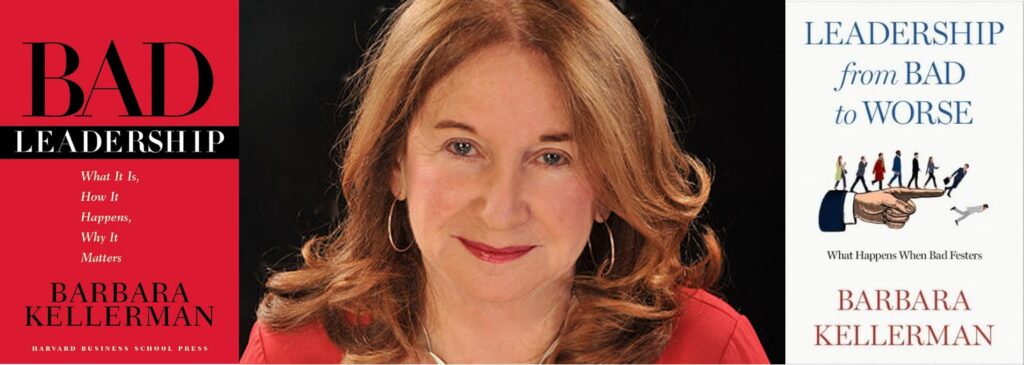Too often, we focus on leaders while neglecting the critical role that followers play in teams, organizations, institutions, and nations. These days, we face major problems with bad leadership, so we’re wise to address what followers can do about bad leaders.
In her book, Bad Leadership: What It Is, How It Happens, Why It Matters esteemed leadership scholar Dr. Barbara Kellerman* examines the critical role of followers and shows how they can not only collaborate with bad leadership but sometimes even cause or facilitate it. (When talking about bad leadership, she means ineffective and/or unethical leadership.) More recently, she wrote Leadership from Bad to Worse: What Happens When Bad Festers.

Bad leadership can only survive and spread when most followers choose not to intervene and when some key followers choose to do the dirty work of the bad leader.
Why Do People Follow Bad Leaders?
Bad leadership cannot thrive in a vacuum. It emerges and gains traction through the passivity or complicity of followers. Followers may enable bad leadership by allowing incompetence, overlooking unethical decisions, or prioritizing loyalty over integrity. In hierarchical or high-pressure environments, desire for inclusion, self-interest, or fear of reprisal can cause people to accept or support the leader’s authority, even when it’s destructive. This creates a feedback loop in which silence is mistaken for approval, further normalizing the leader’s behavior.
Followers may legitimize bad leadership due to groupthink. They can become blind to warning signs, and they can rationalize destructive behaviors. Social dynamics and pressures can discourage independent thought and moral courage.
“Without followers, nothing happens, including bad leadership. Together, leaders and followers can bring out the best in people, as in, say, the civil rights movement; or they can amplify what’s worst in people…. Obviously this finding has moral implications. Leaders and followers share responsibility for leadership, bad as well as good.”
-Barbara Kellerman, Bad Leadership
Dr. Kellerman argues that individual and group needs are a big part of the reason why people follow bad leaders. For many followers, she writes, “Not following is not in their interest. Not following can entail risk—to family, to position, and even to life.” Within organizations, second-guessers, naysayers, and objectors are frowned upon, if not marginalized or dismissed.

Leadership Derailers Assessment
Take this assessment to identify what’s inhibiting your leadership effectiveness. It will help you develop self-awareness and identify ways to improve your leadership.
Social psychologist Jonathan Haidt, Professor of Ethical Leadership at New York University’s Stern School of Business, also shares important insights about why people follow bad leaders. He’s best known for his work on political polarization, the psychology of morality, and the fascinating interplay between reasoning and emotion in decision-making. In his book, The Righteous Mind: Why Good People Are Divided by Politics and Religion, he writes:
“People bind themselves into political teams that share moral narratives. Once they accept a particular narrative, they become blind to alternative moral worlds…. If you think about moral reasoning as a skill we humans evolved to further our social agendas—to justify our own actions and to defend the teams we belong to—then things will make a lot more sense.”

The key to understanding our decision-making is to recognize how much our group identity shapes our decisions. When we’re part of a group that’s important to us, that affiliation can override our advanced reasoning and values. As Haidt writes in The Righteous Mind, “We can believe almost anything that supports our team.”**
“I could stand in the middle of Fifth Avenue and shoot somebody, and I wouldn’t lose any voters, OK? It’s, like, incredible.” -Donald Trump, January 2016
What Followers Can Do about Bad Leaders
Fortunately, followers aren’t powerless when it comes to bad leadership—if they can transcend these cognitive biases and group pressures. When they view the role of followership properly, they have considerable agency. They can help determine whether bad leadership is allowed to flourish.
“Followers have to keep leaders and peers ethically and legally in check. Instead of viewing followers as the ‘good soldiers’ who carry out commands dutifully, we need to view followers as the primary defenders against toxic leaders or dysfunctional organizations.” -Robert E. Kelley, “Rethinking Followership” in Riggio, Chaleff, and Lipman-Blumen, The Art of Followership
Here are several of the actions that followers can take to keep bad leadership in check, according to Dr. Kellerman:
Pay attention. Followers must pay close attention to what leaders are doing. When followers remain vigilant, they can identify early warning signs of bad leadership and hold leaders accountable, helping to protect the organization and its values.

Personal Values Exercise
Complete this exercise to identify your personal values. It will help you develop self-awareness, including clarity about what’s most important to you in life and work, and serve as a safe harbor for you to return to when things are tough.
Be skeptical. Blind trust from followers can let bad leadership go unchecked. Being skeptical means critically assessing not just what leaders say, but also their motives, decisions, and actions. Healthy skepticism fosters accountability and encourages leaders to be thoughtful, transparent, and aligned with the organization’s shared purpose, values, and vision. It ensures that followers are actively engaged in safeguarding the culture and character of the organization.
“Leaders are not gods.” -Barbara Kellerman
Be a watchdog. Followers should actively monitor the actions and decisions of leaders. By remaining vigilant and questioning actions that seem debatable or sketchy, followers can help prevent bad leadership from taking root or gaining traction. Being a watchdog means holding leaders to the highest standards, demanding transparency, and ensuring that the organization remains effective and ethical over time.
Develop your own sources of information. Relying solely on leaders’ narratives can lead to an incomplete or skewed understanding of the situation. By seeking diverse perspectives and gathering information from various sources, followers can make more informed judgments and spot potential issues before they escalate. Such independence ensures that followers aren’t easily misled or manipulated.
Empower yourself. When confronting bad leadership, it’s crucial for followers to develop the knowledge, skills, and confidence to make informed decisions and take initiative. Empowerment allows followers to speak up, challenge decisions that don’t align with ethical standards, and contribute to the venture’s success. Empowered followers can hold leaders accountable while also creating a culture of stewardship in which people step outside their normal roles to protect the group’s imperatives.
Be loyal to the whole and not to any single individual. This broader loyalty ensures that decisions are made with the collective good in mind, not personal allegiance or favoritism. By prioritizing the success of the organization over individuals and factions, followers foster teamwork and keep the focus on long-term shared aspirations.

Leadership Derailers Assessment
Take this assessment to identify what’s inhibiting your leadership effectiveness. It will help you develop self-awareness and identify ways to improve your leadership.
Find allies. Followers are wise to seek allies who share their commitment to ethical standards and collective success. Building a network of trusted peers provides strength in numbers, offering mutual support when speaking out or challenging bad decisions. Allies can offer diverse perspectives and help drive positive change within the organization, ensuring that leaders remain accountable and focused on the right priorities.
Take a stand. In the face of bad leadership, it’s important for followers to take a stand when they witness unethical or ineffective behavior. Standing up, even when it’s difficult, ensures that issues are addressed, protecting the integrity of the organization. Taking a stand demonstrates courage and conviction. It sets an example for others to follow. And it helps to build a culture that values accountability and that demands effective and ethical leadership. (See our article, “Are You Strong Enough to Be a Voice of One?”)
“If I had to reduce the responsibilities of a good follower to a single rule, it would be to speak truth to power.”
-Warren Bennis, leadership scholar
Take collective action. Unified efforts have a greater impact. When followers join together to address issues, whether it’s advocating for change or holding leaders accountable, they’re not only doing the right thing but also building a better culture. Collective action not only amplifies concerns but also demonstrates solidarity and shared values, making it harder for bad leadership to persist.
“…we cannot stop or slow bad leadership by sticking our heads in the sand…. Bad leadership will not, cannot, be stopped or slowed unless followers take responsibility for rewarding the good leaders and penalizing the bad ones.”
-Barbara Kellerman
Hold leaders to account. By actively monitoring leadership decisions and behaviors, and challenging those that are ineffective or unethical, followers reinforce the idea that leadership is a privilege, not a right. When followers hold leaders accountable, it fosters trust and builds a high-performing, high-integrity culture.
Conclusion
Bad leadership erodes trust. It leads organizations or institutions down destructive paths. More often than not, things go from bad to worse.
“The process of going from bad to worse tends to be steady, not sudden or hasty…. once the system is close to being completely corrupted, it’s late, maybe even too late. By then bad leaders and their followers are so entrenched that they control the system itself, which is why at this point the only way to totally get rid of bad is to totally get rid of everyone involved.”
-Barbara Kellerman, Leadership from Bad to Worse: What Happens When Bad Festers
Here’s the thing: bad leadership persists largely because followers allow it to.
What are the enablers of bad leadership? Groupthink. Tortured rationalizations. Blind loyalty. Apathy. Silence.
Followers have more power than they often realize. By asking hard questions, fighting for their core values, refusing to normalize unethical behavior, and demanding transparency and accountability, they help create the conditions in which bad leadership collapses. Ultimately, stopping the spread of bad leadership is a shared duty. And it starts with moral clarity and courage.
–Gregg Vanourek
Reflection Questions
- Are you suffering from the effects of bad leadership?
- What have you done about it so far?
- And what new actions will you take, starting today?
Tools for You
- Leadership Derailers Assessment to help you identify what’s inhibiting your leadership effectiveness
- Personal Values Exercise to help you determine and clarify what’s most important to you
- Traps Test (Common Traps of Living) to help you identify what’s inhibiting your happiness and quality of life

Personal Values Exercise
Complete this exercise to identify your personal values. It will help you develop self-awareness, including clarity about what’s most important to you in life and work, and serve as a safe harbor for you to return to when things are tough.
Related Articles & Books
- “Rating Your Job: A Work Satisfaction Checkup”
- “BAD Leadership: 7 Types”
- “Why People Fall for Toxic Leaders”
- “Toxic Leaders, Susceptible Followers”
- “The Problem of Bad Leaders—And Why We Keep Following Them”
- “Elevating Your Leadership”
- “Why Are We Talking about Ethics?”
- “The Importance of Integrity in Leadership”
- “The Root Causes of Ethical Failings (and Our Political Dysfunction)”
- “The Trump Leadership Playbook–And Why It Matters”
- “What to Do If You Work for an Unethical Organization”
- “What to Do If You Work for a Toxic Boss”
- Barbara Kellerman, Bad Leadership: What It Is, How It Happens, Why It Matters (Harvard Business School Press, 2004)
- Barbara Kellerman, Leadership from Bad to Worse: What Happens When Bad Festers (Oxford University Press, 2024)
- Jean Lipman-Blumen, The Allure of Toxic Leaders (Oxford University Press, 2005)
- Ira Chaleff, To Stop a Tyrant: The Power of Political Followers (Greenleaf Book Group, 2024)
Postscript: Quotations on the Role of Followers in Bad Leadership
- “Bad leaders do not typically wake up one morning and say, ‘Golly gee, I’ve been bad. I need to change my ways.’ They will stop being bad only if someone else or something else stops them. And if nothing stops them and no one stops them, they will go from bad to worse.” -Barbara Kellerman
- “…once they’re entrenched, bad leaders seldom change or quit of their own volition. This means it’s up to us to insist either on change—or on an early exit.” -Barbara Kellerman, Bad Leadership
- “It’s really important for our company to have a culture of healthy leadership and also healthy followership. We don’t want to over emphasize leadership because it’s not the most important thing. Leadership is important, followership is important, and collaboration is important.” -Hendrith Vanlon Smith, Jr., Managing Partner, Mayflower-Plymouth
- “History will have to record that the greatest tragedy of this period … was not the strident clamor of the bad people, but the appalling silence of the good people.” -Martin Luther King, Jr.
- “What country can preserve its liberties if its rulers are not warned from time to time that their people preserve the spirit of resistance?” -Thomas Jefferson, former U.S. president
- “When injustice becomes law, resistance becomes duty.” -Alexei Navalny, Russian dissident
- “Nothing is ever finally safe. Every important battle must be fought and re-fought.” -John W. Gardner, political reformer
- “The price of freedom is eternal vigilance.” -Thomas Jefferson
* Dr. Barbara Kellerman has been a professor at several universities, including Dartmouth, Fordham, and Tufts. She is a Fellow at Harvard University’s Center for Public Leadership and was its founding Executive Director. Kellerman was also a co-founder of the International Leadership Association and has been ranked among the “Top 50 Business Thinkers” by Forbes.com.
** Other examples of such surprisingly powerful loyalty to leaders:
- According to his personal notes and accounts from close aides, including the memoirs of Albert Speer (Minister of Armaments and War Production in Nazi Germany), Adolf Hitler often expressed surprise in private about how far people would go for him–about their blind devotion to him and readiness to sacrifice everything for him.
- Cuban dictator Fidel Castro expressed both surprise and pride at how many Cubans showed deep loyalty to him, perhaps even being willing to die for him during the revolution and afterward, despite the extreme hardships they suffered.
- “I love my people so much, and they love me. Sometimes I wonder what I did to deserve that love.” -Jim Jones, in recorded sermons prior to the mass murder-suicide of many of his followers (Jonestown Massacre)

Triple Crown Leadership Newsletter
Join our community. Sign up now and get our monthly inspirations (new articles, announcements, opportunities, resources, and more). Welcome!
+++++++++++++++++++++++
Gregg Vanourek is a writer, teacher, and TEDx speaker on leadership and personal development. He is co-author of three books, including Triple Crown Leadership: Building Excellent, Ethical, and Enduring Organizations (a winner of the International Book Awards written with his father, Bob Vanourek) and LIFE Entrepreneurs (a manifesto for living with purpose and passion). Check out his Leadership Derailers Assessment or join his rapidly growing community. If you found value in this, please forward it to a friend. Every little bit helps!



2 thoughts on “What Followers Can Do about Bad Leaders”
Gregg
I would like you to consider adding my latest book to your recommended resources: To Stop a Tyrant: The Power of Political Followers
My Best
Ira Chaleff
Hi Ira. We’re honored to hear from you and yes, of course we’re happy to do so. Doing that now. Congrats on your latest book, Ira, and keep up the good work! -Gregg